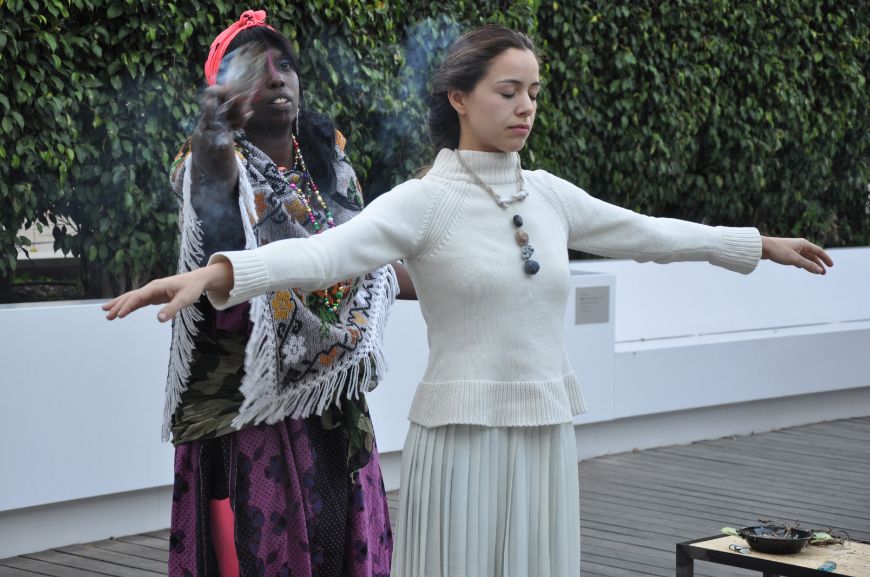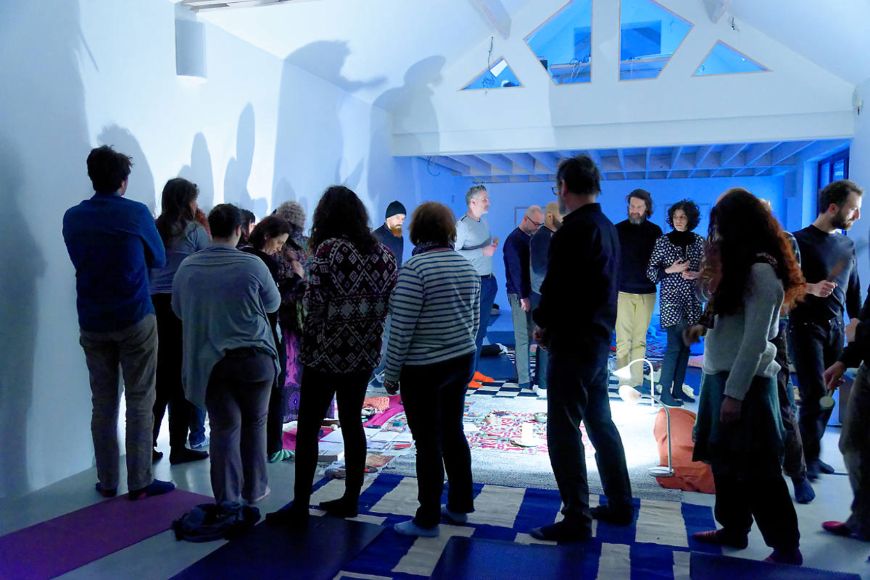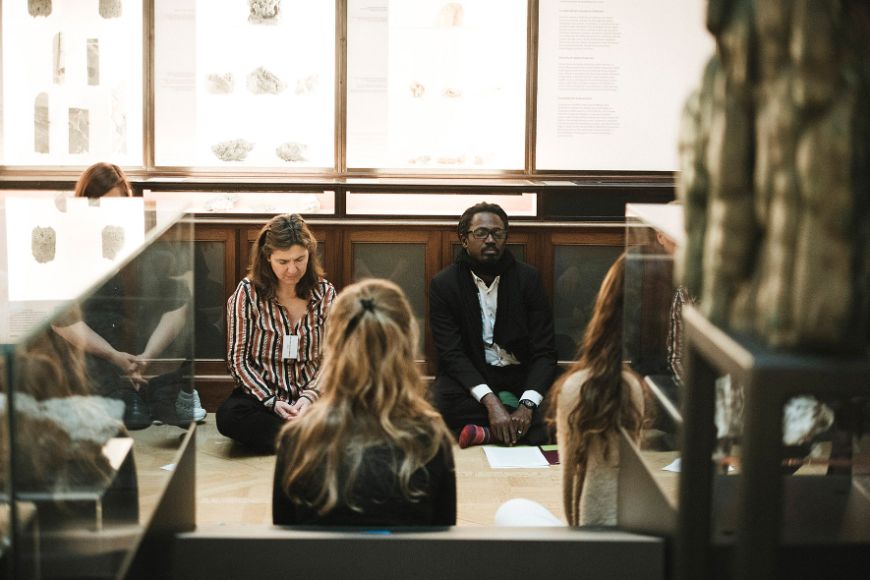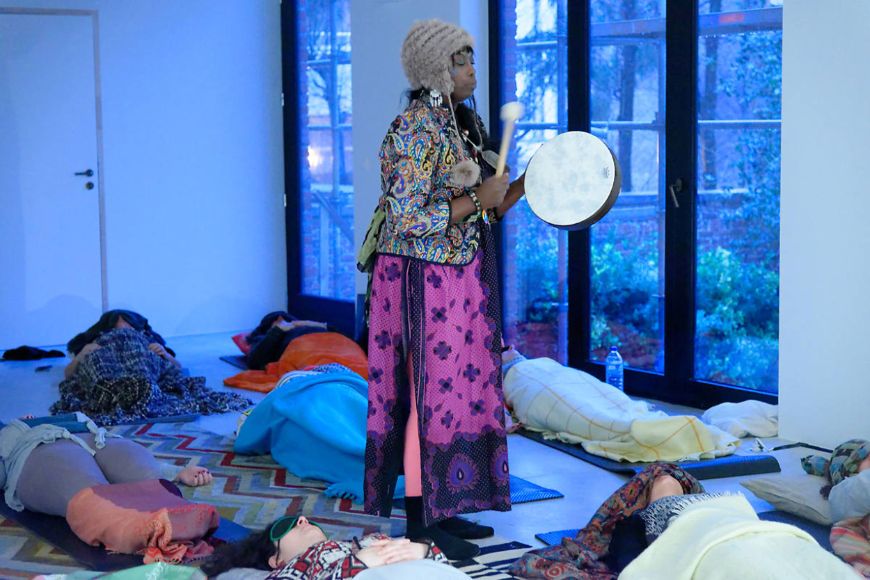Text | Conversation | Gropius Bau 2022
Healing The Museum
By Grace Ndiritu

How can artists influence institutions as they look to address urgent questions of care, social welfare and the legacies of colonialism?
As part of an ongoing body of work since 2012, in Healing The Museum, Grace Ndiritu uses shamanism, practices of sharing and group meditations as well as ideas of healing and reconciliation, joint land ownership and entangled life – often based on the notion of the commons – to create different ways of seeing and existing, breaking down established boundaries and dualisms. Healing The Museum is highly influential within institutions’ efforts to understand decolonisation and healing – currently via invitations to speak at the annual conference for the International Council of Museums (ICOM) in 2021 and through behind-the-scenes-discussions with the German Foreign Ministry, part of the legacy of the Goethe Institute’s recent research project Everything Passes Except the Past on decolonising museum spaces in Europe curated by Jana Haeckel from 2018 to 2020.
In 2018, Ndiritu was invited to a residency at the Thalielab Foundation in Brussels – a city coming to terms with the Islamic State attacks of 2016-17. Ndiritu’s focus on healing trauma involved working with refugees and activists as well as employees of the European Parliament, the UN and NATO, the Foreign Office and high court judges, both in separate “strands” and all together, trying to realign “top-down” dynamics. For four months, Ndiritu gave free creative visualisation workshops and meditation sessions, culminating in a shamanic performance with the participants in which many of them had visions around the effects of climate change – inspiring one participant to publish a paper seeking to define the concept of a climate refugee, which is now part of the European Parliamentary Research Service (EPRS).
In 2020-2021, Ndiritu established “The Year of Black Healing”, an artistic response and counter-balance to politicians’ attempts to co-opt Black Culture. In particular, Ndiritu was responding to President Macron’s attempts to reset France’s relations with Africa by declaring 2020-21 the “Year of Africa”, while at the same time failing to act on the restitution of cultural artefacts to Africa as recommended by the 2017 Sarr-Savoy Report.
Incorporating research, film, healing and shamanism, The Year of Black Healing(2020-2021) took place in Canada, Argentina, Italy, France, Belgium, the UK and the US, not only breaking down dualism within institutional ways of seeing but also working with Indigenous and diasporic communities across the world, all under the wider rubric of understanding how stolen land, culture, climate and artefacts can be addressed at both micro and macro levels.
In the first of her two-part artist text written in 2016, Ndiritu shares the foundational impetus of her Healing The Museum methodology, which is based on the idea of using performance as a peace-building tool to deal with issues of global conflict.
– Editors

Grace Ndiritu, Dreaming the Museum Back to Life: The Inner Life of Objects, 2017, performance documentation, Fundació Antoni Tàpies, Barcelona.
“Man is a social being. Factors such as political conflict, social tension and economic stress affect his mental health. Such factors are at least as important as biological factors. Frantz Fanon paid particular attention to these social problems and his brand of political psychiatry is as relevant today as it was during his time. Alienation and oppression still exist. Unemployment is widespread and tyrannical rulers still oppress their people. Mental illness cannot be solved by drugs but by changes in the political and social order.” (1)
In 2012, I began creating a new body of works under the title Healing The Museum. It came out of a deep need to re-introduce non-rational methodologies such as shamanism in order to reactivate the “sacredness” of art spaces. I believed that most modern art institutions were out of sync with their audiences’ everyday experiences and the widespread socio-economical and political changes that have taken place globally in the recent decades. Museums are dying. And I see shamanism as a way to re-activate the dying art space as a space for sharing, participation and ethics. From prehistoric to modern times the shaman was not only the group healer and facilitator of peace but also the creative – the artist.
I choose to develop this practice because collective healing ceremonies allow us to weave together threads of intention, peace, love, equality and harmony to support social change, bridge social divides and heal ancient rifts – even around issues that have gone unresolved for centuries. Many people associate shamanism with personal healing, but similar practices can be applied to create shifts in challenging situations at all levels, including the global. And I believe that these symptoms that are present in society – for instance, the destruction of the environment, mass human migrations and an increase in global acts of terrorism, specifically in Europe in the last years – are a reflection of the fragmentation of the collective mind.
Therefore, at the core of the methodology of Healing The Museum is the idea of using performance as a peace-building tool to deal with issues of global conflict which are currently taking place in the world. This includes countries that are at differing stages of rebuilding their societies post-conflict and which are in the process of attaining a permanent peace solution. Using shamanic performance as a tool for conflict resolution and peace building is not only a way of “healing” the Museum*, it is also an attempt to understand the “Other”, again by making the world a safer, more generous place. Using the Museum as a performative platform within the human history of gift-giving is an attempt to heal the distrust by Western people to trust non-Western methodologies in the aftermath of genocide, slavery and colonialism.

Grace Ndiritu, Dreaming the Museum Back to Life: The Inner Life of Objects, 2017, performance documentation, Fundació Antoni Tàpies, Barcelona.
Various factors have inspired me to adopt this new way of working. First, I grew up in an activist household with a feminist mother who believed in the power of grassroots politics. From a young age I have taken part in anti-war, pro-multiculturalism, anti-racism, anti-apartheid and pro-peace rallies. I see critical thinking as a key mental faculty that needs to be actively cultivated by all humans and channelled by the institutions that we have created. Indeed, Museums should play an important role to counter the culture of fear that is propagated by the mainstream media. The fixation on war has led to an unhealthy mass reliance on government, and especially agencies like the UN to solve all of the problems of global conflict and to take care of all citizens. The people have given away their power to these institutions (until events initiated by the Occupy movement) by allowing them to make decisions for them and, therefore, have played their part in screwing up the democratic process. Misuses of the democratic process by right-wing nationalist groups including the UK Independence Party (UKIP) during the 2016 Brexit campaign (2) and the elections of Donald J. Trump, stoked populism, often with pro-racist overtones, thus making Healing The Museum even more relevant.
Second, these questions reflect the deep fragmentation of approaches to living and being within the collective mind. Where once the Museum could be seen as a safe place in which to espouse our views, the reliance on corporate sponsorship has changed the relationship between the Museum and the public forever. How can we, in turn, see contemporary art as a tool to activate good in the world? How can the general public regain the faith it has lost in contemporary art and Museums to remake the world and show a different way to move forward?
Most modern institutions like the UN and Museums founded after the First World War are currently out of sync with what their citizens and audiences need. I see shamanism as a way to re-activate the dying Museum as a space for sharing by using the concept of “commensality”: sharing a meal together. Commensality is a lived concept that all cultures and religions have once used throughout history. It is also a cathartic way of excising the “demons” of war. Rather than giving into the Freudian inevitability that we as humans are just violent animals in a constant state of reaction, Healing The Museum shows that we as humans can use our consciousness to rise above violence. In my project, I want to dig deeper into the subconscious of the human psyche and employ a Jungian idea of using non-rational methods like shamanism to heal the collective mind.

GDocumentation of Grace Ndiritu’s performance Healing The Museum (2019) as part of the Everything Passes Except The Past conference at the Africa Museum, Brussels.
Therefore, Healing The Museum incorporates the acts of listening and receiving, giving and sharing, while requiring the trust of all participants and audiences to take place. By trusting each other, they will see the holistic, bigger picture that we as humans are all connected. I aim to trigger a global movement for peace subliminally in which both the audience and participants can go back to their jobs and relieve the pressure working within these powerful institutions that make decisions on a daily basis which affect everyone.
“Soul loss is also happening on a larger scale on the entire planet. Soul loss is not limited to individual human experience. It is also quite evident that societies experience this. Examples of collective soul loss and its effects can be found by studying the experience of cultures, such as Native American cultures that have experienced genocide, or cultures in Africa in which the demoralisation generated by colonialism has created a cultural, political and spiritual vacuum. The Earth herself is in a state of soul loss due to the war that has been waged against her by unbridled industrialisation. Even so, I have great faith in her regenerative capacity. There is much we can do as shamanic practitioners to heal, safeguard and restore the Earth and the beings that dwell there. Working on a spirit level makes many things possible. So much that happens in spiritual reality affects material reality. It is important to remember this even though the effect of spiritual healing, like soul retrieval, may not always be immediately evident on a material level.” (3)
Thus, it is interesting to note that the only trace of any live event – especially one that chooses to affect the unconscious in a non-rational way – can only play out in the memories of the participants that attended in the days and weeks to come. The capturing of the “dead” performance onto film can only provide a sneak peek at the long-term goal of Healing The Museum as an instigator and participant in a new wave of positive development in human consciousness currently taking place. The main principle of the Healing The Museum series is to enliven the Museum once again back into action so that it can claim its proper place – as a cultural space in which new advancements in art, audience participation and art education can affect wider society and life for the good of all beings.

Grace Ndiritu, A Meal For My Ancestors: Healing The Museum, 2018, performance documentaion, Thalielab Foundation, Brussels Thalielab Foundation, Brussels
Grace Ndiritu is a British-Kenyan artist whose artworks are concerned with the transformation of our contemporary world. Her works including The Ark: Center for Interdisciplinary Experimentation; COVERSLUT©; and the performance series, Healing The Museum, have been shown around the world since 2012. Ndiritu has been featured in TIME magazine, The 21st Century Art Book (London: Phaidon, 2014), Art Monthly and Elephant magazine. Her work is housed in museum collections such as The Metropolitan Museum of Art, New York, The British Council Visual Arts, London and The Modern Art Museum, Warsaw. Her writings have been published in her critical theory book Dissent Without Modification (Bergen Kunsthall, 2021), Whitechapel Gallery's series: Documents of Contemporary Art Anthology (2006–ongoing), Animal Shelter Journal, Semiotext(e) The MIT Press, Metropolis M and The Oxford University Press.
*Museum is deliberately capitalised in this text contribution.
Endnotes
1. Hanafy A. Youssef and Salah A. Fadl, Frantz Fanon and Political Psychiatry, 1996
2. Cambridge Analytica was accused of amassing the data of millions of Facebook users without their consent and using it in political campaigns, including the 2016 US Presidential campaign and 2016 Brexit referendum. A three-year probe into the misuse of personal data, centring around the activities of the firm, ended in 2020, finding that Cambridge Analytica was “not involved” in the EU referendum, says the Information Commissioner, “beyond some initial enquiries made... in the early stages” around UKIP. The investigation led to big fines for Facebook and two pro-Brexit campaign groups - Vote Leave and Leave.EU. For further information please see: “Cambridge Analytica ‘not involved’ in Brexit referendum, says watchdog”, www.bbc.com/news/, 7 October 2020 (accessed 26 July 2021)
3. Gerri Ravyn Stanfield, “An Interview with Isa Gucciardi, Ph.D. on Soul Retrieval”, 2021 (accessed 26 July 2021)